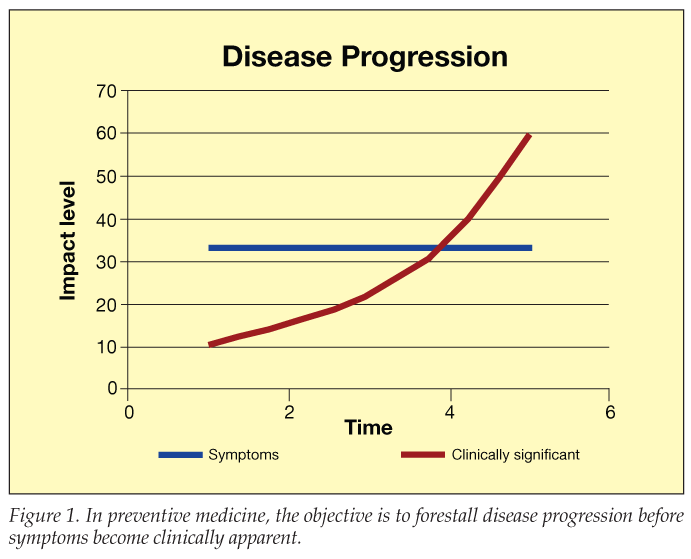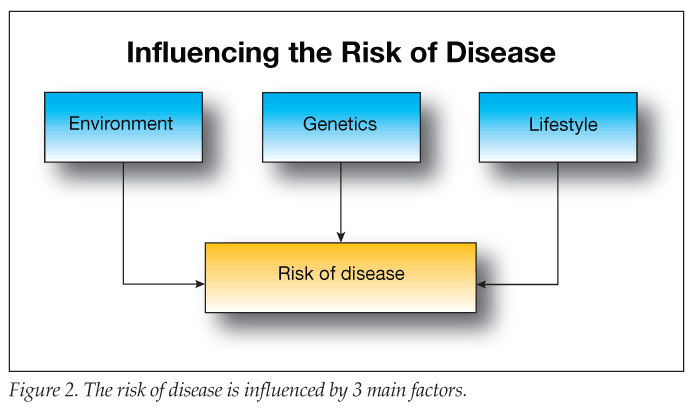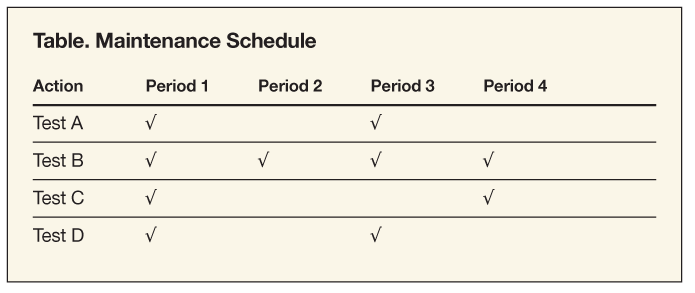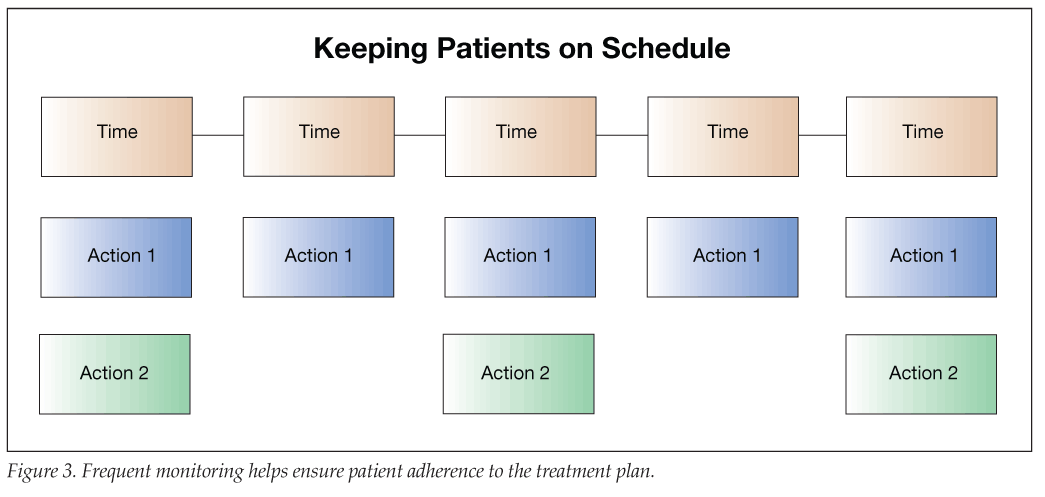Prevention as a Replacement for Breakdown Medicine
Much of health care today consists of treatment of disease. Few resources are allocated to prevent disease. Many treatments are not delivered optimally because of a lack of patient discipline and insufficient follow-up by physicians and other health care providers.
Key words: Prevention, Patient adherence, Health maintenance
The benefits of emphasizing prevention have been recognized for a long time. Results of study after study1,2 confirm Benjamin Franklin’s adage that “an ounce of prevention is worth a pound of cure.” This concept applies to practically every activity that involves component parts that can fail. Even such a magnificent creation as the human body still needs to be properly maintained or its components can fail prematurely.
We are all familiar with the need for regular maintenance of our automobiles. By analogy, health care can be improved by applying concepts of maintenance management. Properly maintained equipment provides higher reliability and lower costs overall than equipment that is not well maintained. The body that is well used and cared for will last longer and provide a better quality of life. Besides, replacement parts for our bodies are very expensive, if available at all.
Beginning in the early 1980s, HMOs were established with the express goal of decreasing costs by “managing” the delivery of health care. Each patient was assigned a primary care provider (PCP), also known as a “gatekeeper,” to oversee the provision of care over the patient’s lifetime. A capitation payment system-under which the physician was paid a fixed amount per person regardless of services rendered-would encourage PCPs to keep their patients healthy and within budget through use of preventive medicine and by controlling patients’ access to specialists-at least, that was the premise.
HMOs have not achieved a significant decrease in health care costs or an increase in the use of preventive medicine. The primary reason for unrelenting cost increases is inherent in the third-party payer system, with patients and providers largely insulated from the true costs of health care. Other factors include cumbersome health management efforts focused on obtaining prior authorization and lack of active patient engagement in taking responsibility for their own health. Prevention efforts still lag. A new approach to health care is needed.
Concepts of Maintenance
Industrialized societies depend on the smooth operation of many types of equipment and recognize the importance of regular maintenance. The more we rely on the uninterrupted service of equipment, the more important its reliability. Industries dependent on heavy equipment, such as power generation and process manufacturing, use sophisticated approaches to increase equipment reliability and longevity. For our bodies to function reliably and without problems, the same concepts should apply.
Mean time between failures. The mean time between failures (MTBF) is a metric that describes the reliability of a piece of equipment. The MTBF value is computed from the failure history by dividing the time period by the number of failures of a group of like equipment.
In health care, the MTBF may represent the number of encounters experienced by a particular population. For example, a given patient population will average a certain number of physician office visits each year. The goal is to increase the MTBF of a population. For individuals, an example of a MTBF could be the interval between colds. Individuals can take precautions, such as loading up on vitamin C so that the MTBF expands. Any visits for preventive maintenance, such as a flu shot, are not counted as failures in this context.
Breakdown maintenance. With breakdown maintenance, one waits until something breaks and then repairs are made. This approach is typically used with equipment that can be easily replaced and that will not cause major problems when it fails. Well-run maintenance departments strive to limit breakdown maintenance to accidents only.
In health care terms, this represents waiting until one is ill and then going to the doctor. Sometimes we wait until we are very sick before seeking help. Breakdown maintenance is not appropriate for us because our body parts are not easily replaced and lack of maintenance can cause major problems. Indeed, this approach is responsible for a large proportion of health care services today and is a major contributor to high health care costs.
Preventive maintenance. Preventive maintenance uses knowledge of the equipment to ensure that certain measures are taken so that it can function optimally. For example, understanding the essential role of motor oil in lubricating an engine’s moving parts dictates changing the oil at regular intervals. Many pieces of equipment have detailed maintenance schedules that are designed to address and prevent problems the equipment can be expected to encounter.
In health care terms, medical knowledge is used to schedule screenings to check for signs of impending failure. The value of the annual physical examination is well accepted. Many screenings are recommended at specific ages, such as a colonoscopy at age 50 years. Forchildren, the treatment and vaccination schedule is typically followed rigorously by their conscientious mothers, but adherence tends to wane as we grow older. We pay attention to our health only after the consequences of our carelessness start showing up as health problems and we can no longer ignore them.
Predictive maintenance. Predictive maintenance is a modification of the preventive maintenance concept. Where preventive maintenance covers all equipment of a certain type, predictive maintenance uses a “condition” as the driving parameter. The time for the next maintenance is determined on the basis of the current condition. For example, if the machinery is operated in a dusty environment, filters need to be changed more frequently. The schedule for predictive maintenance is often driven by periodic inspections. For example, if rust spots on equipment have increased in number and thickness since the last observation, observation frequency may need to be increased.
In health care, this means that certain tests or treatments are scheduled based on the person’s condition. The schedule may be influenced by the person’s lifestyle, the environment in which the person lives and works, and/or the risks associated with the individual’s genetic makeup. If results of any of the specific tests indicate a change, the interval between the tests may be shortened to ensure proper follow-up.
Maintenance schedules. Most costly and complex equipment comes with a maintenance schedule. This is a program of preventive services associated with some easily measured value. For example, each motor vehicle comes with a schedule of service work associated with having reached a particular mileage. The schedule is harmonized to increase efficiency so that less frequent services occur on a multiple of more frequent services. A maintenance schedule to promote good health would tie preventive health care measures to a specific time line.
Adherence. Much study is dedicated to the development of the optimal maintenance methodology. The results of such studies are codified in optimized procedures-sometimes called “best practices.” For example, if we know that a piece of equipment will fail with high probability after a certain number of cycles, we can count the number of cycles and plan to replace the part shortly before the failure would typically occur. The more critical the equipment, the more important is compliance with the optimal maintenance procedure. The aircraft industry is particularly committed to compliance with maintenance procedures because of the catastrophic consequences of failure. In health care terms, this means that if we consider certain functions of the human body critical, we should meticulously follow optimal procedures to keep it functioning well.
A quick search on the Internet using the search engine Google results in 10.5 million hits for “preventive medicine,” 3.38 million for “predictive medicine,” and 340,000 for “an ounce of prevention is worth a pound of cure.” Given the acceptance of the virtues of preventive medicine, it is surprising that it is not a more prominent part of health care. In order to change that, both providers and patients need to better understand and accept the value of prevention.
Health Maintenance Approach
Application of sound maintenance principles applies equally to health care and could lead to a substantial improvement in the health of the population. Current health care practice focuses almost solely on treatment once a disease has taken hold. This is equivalent to the “breakdown maintenance” approach for equipment.

tracks the progress of a typical disease. The “symptoms” line shows the impact of the disease increasing over time. The line labeled “clinically significant” indicates the level at which symptoms become apparent to the patient. At the point where these two lines intersect, the patient visits his or her physician and treatment begins. The preventive approach focuses on intercepting the disease before it reaches a clinically significant level.
The goal of preventive health care is keeping persons healthy for most of the time. The earlier a disease is detected, the better the chances for a complete recovery. Treatment of a disease in its early stages typically costs less as well. The cost of multiple oil changes is far less than the cost of replacing the engine.
Preventive health care is a focus of much research. This research has produced a number of screenings for cancer and many specific tests that correspond to known chronic conditions.3 Research into the human genome has revealed many correlations between the presence of a certain gene and the propensity for a certain condition to develop.3

The risk of disease is affected by a combination of elements. The elements are typically grouped under environment, lifestyle, and genetics (Figure 2). Minimizing the risk of disease requires that the preventive medicine be both personal and risk-based.
A personal focus requires that we focus on each patient individually. The statistically low probability of being struck by lightning is of no consolation if you are the one who is hit. A risk-based focus requires that the providers of preventive health care must take into account the patient’s high-risk areas based on environment, genetics, and lifestyle. Knowing the specifics of the patient’s environment, genetics, and lifestyle allows health care professionals to focus on the small number of high-risk persons.
Health maintenance schedule. A health maintenance schedule is an organized list of specific actions to be performed over a certain period. This schedule needs to be individualized for each person. This schedule can incorporate cancer screenings, diagnostic tests, and other actions typically required for persons of a certain age, sex, health status, lifestyle, environment, and genetic predisposition.
In order to manage the individual health maintenance schedule properly, each person should have a personal health record regardless of whether he is sick or healthy. This record details all preventive medicine procedures of all physicians and also tracks the patient’s adherence to the maintenance schedule. The maintenance schedule needs to be updated to reflect any new conditions or changes, such as a new diagnosis of hypertension or new knowledge in preventive medicine.

A sample maintenance schedule is shown in the Table. All activities are scheduled. Test A is performed every first and third period while test B is performed every period. Test C is performed every first and fourth period and test D is performed every first and third period.
A healthy person who follows a maintenance schedule that is individualized and reflects the latest in preventive medicine will have the best opportunity to maintain good health. With the focus of preventive medicine on detecting problems before they reach the clinical stage, for each problem, changes in lifestyle (healthful diet, increased level of physical activity, etc) and targeted use of nutritional supplements and/or medications may keep the disease from developing further. In addition, when the physician is aware of the presence of an incipient chronic condition (such as diabetes), he can adjust the health maintenance schedule to take into account the new situation.
Maintenance programs can also help employers improve the health of their employees. Employers, especially those who are self-insured, are well positioned to offer these programs with appropriate incentives and to benefit from the improved health of their employees.
Treatment plan and adherence. The treatment plan lists a series of visits, medications, or other actions that are prescribed as the optimal approach to treating the patient’s disease. Treatment plan adherence consists of content adherence and schedule adherence. Content adherence encompasses monitoring medication use, follow-up visits, and any other prescribed activity defined in the treatment plan. Schedule adherence refers to whether appointments are kept.
Treatment plans are similar in structure to the health maintenance schedule, although not preventive. Even surgery will have a treatment plan: the wound needs to be inspected after a certain amount of time following surgery, pain medication is typically needed for several days, etc.
Adherence to the treatment plan is important in terms of understanding and timing. For example, when the physician prescribes an antibiotic for a certain number of days, all of the medication needs to be taken even though the patient may feel better after the first dose. Stopping medication early diminishes the effectiveness of the treatment. It is surprising-and concerning-that less than 20% of prescribed medication is taken as prescribed.4 The consequences of low adherence levels are ineffective treatment and increased costs.5,6

shows the treatment plan with a time line and with various actions performed at defined intervals. Each action represents a visit to a physician’s office, taking a pill, or obtaining a diagnostic test. Frequent monitoring of and interaction with the patient on the treatment plan improve outcomes while the providers’ revenues are also increased because visits are not missed, prescriptions are refilled on schedule, and proper follow-up is maintained. Pharmacists who implement a consistent plan of adherence monitoring can not only improve overall health of the population but also benefit by ensuring that refills are filled and that patients are reminded to adhere to the treatment.
The actions within the treatment plan may include monitoring of lifestyle changes. For example, the action may include increased physical activity or adherence to specific dietary recommendations. Patients may be able to record their activities using an Internet portal. Monitoring of a large number of patients is best accomplished with the use of technology. The technology can improve quality and minimize costs associated with follow-up. Automated systems can be used to issue reminders and measure adherence levels.
Monitoring treatment adherence requires motivation and metrics. Money is an effective motivator. Employers who self-insure may want to consider establishing rate differentials that reflect treatment adherence levels. Providers may use prepayments as a means of ensuring patient follow-through. A consistent system of reminders and an easy identification of adherence problems provide an infrastructure for efficient monitoring.
Close monitoring and reminders may raise valid questions about “big brother” overseeing our lives. These are important questions with an easy answer: if employers are paying for the lion’s share of employees’ health care costs, they have the right to know whether treatment plans are being followed properly. The follow-up is an issue of quality control and not of interfering with one’s freedom.
Opportunity for primary care providers. PCPs are at a disadvantage in the current health care system. Health insurers are much more willing to pay for a procedure than for the equally demanding time spent by a PCP in management or prevention of disease. They will pay more to the surgeon removing the leg of a person with diabetes than to the internist keeping the diabetes under control and avoiding serious complications. Preventive primary medicine not only saves money but allows the patient to keep his leg.
PCPs can benefit from focusing their practice on preventive medicine. Implementing a comprehensive preventive medicine program that includes not only patients but also their families and other currently healthy people will increase the number of visits to the practice. It will also strengthen the reputation of the practice by having more patients take an active role in promoting wellness.
Preventive maintenance visits can be made quite standard and require only minimum involvement of the PCP. Most of the activities can be streamlined to ensure efficient delivery. Patient experience is improved and practice profitability is increased. Preventive health care, implemented in an efficient manner with maximum use of technology may bring substantial economic benefits. Any concern that this will increase the cost of medicine can be allayed by comparing the costs of fully developed disease with the costs of prevention. Rather than spending larger somewhat unpredictable amounts on specialty care, health plans will spend smaller and more predictable amounts on primary care.
The primary practice that actively pursues preventive health care will improve patient health. By engaging patients to take more responsibility in taking care of their health, primary care should be in the forefront of medicine that focuses on maintaining health rather than on treating disease.
Summary
Health care delivery can benefit from implementing methodologies used in the maintenance of equipment. Too much is spent on “breakdown” maintenance rather than on “preventive” maintenance. While the benefits of prevention are clear and mostly well accepted, the implementation of rational prevention-oriented health care will require a substantial change in behavior of both health care providers and patients.
A health maintenance approach focuses on maintaining health rather than treating disease. Apparently healthy individuals may have a disease that has not progressed enough to show clinically significant symptoms. Once the disease is apparent to the patient, it may be so developed so that it is expensive or impossible to heal. Early detection can be a true lifesaver.
A large body of knowledge is available that can be used by health care professionals to build a comprehensive health maintenance schedule that is specifically suited to each individual.7,8 Providers can tailor treatment and health maintenance plans to individuals to ensure the highest quality of health care.
PCPs can greatly benefit from actively refocusing their practices on preventive medicine. Such participation does not require expensive equipment or complicated computer technology-it just puts already existing medical knowledge to work improving patient health.
Proper incentives are necessary to increase use of preventive medicine. In equipment maintenance of large plants, such incentives are already in place-the fewer failures occur, the better is the pay of the maintenance workers. Maybe we should compensate PCPs for patients who are healthy or for the number of preventive visits as a percentage of their practice.
While it is logical and makes good sense, the change will not be simple. Transition to prevention-oriented medicine requires changes in the current system and in patient behavior. Change will naturally be resisted by many who operate profitably in the current environment. However, given that our current system of providing “breakdown medicine” is not financially sustainable and also what is at stake, the effort we dedicate to replacing the current system with one organized around preventive medicine is long overdue and definitely worth it.
References:
References
1. Partnership for Prevention. Preventive care: a national profile on use, disparities, and health benefits. 2007. National Commission on Prevention Priorities. www.prevent.org/images/stories/2007/ncpp/ncpp%20preventive%20care%20report.pdf. Accessed February 11, 2009.
2. Scrimshaw SC, White L, Koplan JP. The meaning and value of prevention research. Public Health Rep. 2001;116(suppl 1):4-9.
3. Zoorob R, Anderson R, Cefalu C, Sidani M. Cancer screening guidelines. Am Fam Physician. 2001;63:1101-1112.
4. Wertheimer AI, Santella TM. Medication compliance research: still so far to go. J Appl Res Clin Exp Ther. 2003;3:254-261. www.jrnlapplied research.com/articles/Vol3/Iss3/Wertheimer.htm. Accessed February 11, 2009.
5. Peterson AM, McGhan WF. Pharmacoeconomic impact of non-compliance with statins. Pharmacoeconomics. 2005;23:13-25.
6. Richter A, Simpson KN, Mauskopf JA. Impact of drug non-compliance and the frequency of viral load testing on outcomes, costs and patterns of therapy. Int Conf AIDS. 1998;12:807. Abstract 42173.
7. Kirisits C, Lang S, Dimopoulos J, et al. Uncertainties when using only one MRI-based treatment plan for subsequent high-dose-rate tandem and ring applications in brachytherapy of cervix cancer. Radiother Oncol. 2006;81:269-275.
8. Hope CS, Laurie J, Orr JS, Halnan KE. Optimization of x-ray treatment planning by computer judgement. Phys Med Biol. 1967;12:531-542.